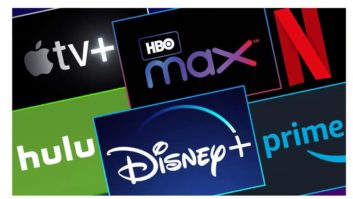Apple’s highly publicised streaming service lands in over 100 countries on 1st November, bringing with it a slate of original content that runs the gamut from Snoopy in Space to Aquaman doing the Bird Box Challenge (See, pictured below). But unless you’ve been living under the other kind of slate for the past year, you may have noticed a raft of rival SVoD services sailing into view – most notably Disney+, the only streamer where you’ll be able to watch both versions of That Darn Cat! – so can Apple TV+ take a bite out of the streaming market, or should the company take media mogul Barry Diller’s advice and “get back to fixing the iPhone”?
For starters, the company has a ripe customer base and has elected to offer a year’s free Apple TV+ subscription with any device purchase, which Barclays predicts will give Apple over 100 million subscribers in the first year alone (for comparison Netflix has over 150 million). For Alice Enders, head of research at Enders Analysis, this represents a smart way of picking low-hanging fruit: “Since it’s a game of sub numbers for the financial markets, signing up your existing customers (even at zero cost) is a no-brainer and they may eventually love it so much they pay.”
Additionally, Apple reportedly plans to launch a 5G device next year, potentially bringing more users on board. “While there is potential for drop-off when the existing free year of access expires for the latest device owners, those wishing to access 5G through their smartphones may upgrade, creating a new batch of consumers with Apple TV+,” says Toby Holleran, senior analyst at Ampere Analysis. “Additionally, as the quantity of content available on the service increases, there could be more incentive for consumers not to churn once they begin paying.”

On the content side, Apple has all its eggs in one basket, having spent $6 billion on original content rather than licensing existing titles. So despite the company’s high-profile partnerships with the likes of Steven Spielberg and Oprah, Enders notes the “less than certain appetite internationally for US content,” adding that “it’s simply not a Netflix competitor.” A survey by Ampere Analysis confirmed this scepticism, finding lack of interest in content to be respondents’ biggest barrier to subscribing.
Meanwhile Disney+ is expected to beat Netflix in terms of subscribers, according to JP Morgan. That Apple’s service launches before that of Disney, which has yet to announce a UK launch date, offers little advantage from Enders’ point of view. “Don’t forget that Disney is a much more recognised brand for entertainment, thanks to the films, merch and parks, and it is already front of mind for pay-TV customers that take film packages or watch the channels,” she says.
The earlier launch is also countered by the rise of SVoD stacking, as Minal Modha, consumer research lead at Ampere Analysis, explains: “Currently in Europe, as with a lot of places, our data shows that SVoD stacking is continuing to grow as consumers aggregate services to curate their own schedules. This suggests that we have not hit the ceiling yet for new services so Apple launching in Europe before Disney may not actually make too much of a difference, although we might be in a different place in 12-18 months.”
At £4.99 a month, Apple TV+ is cheaper than both Disney+ and eating an apple a day. Time will tell whether that will be enough to keep Disney away.







